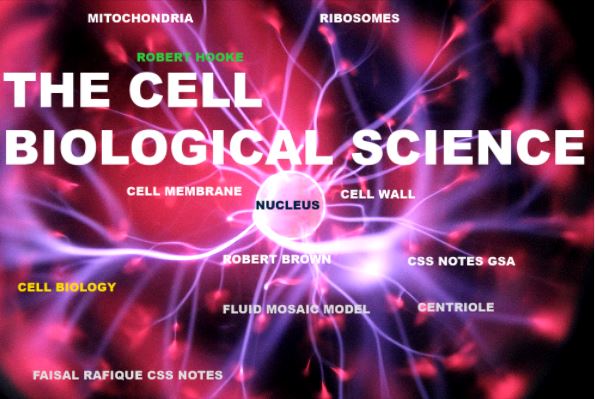THE CELL : BIOLOGICAL SCIENCES GSA:

Background:
- Living thing (Plants,Animals and Microbes).
- Derived from cellula (small room).
- Microscopic Structure.
==> It was discovered by Robert Hooke in 1665.
==> Later on it was discovered by Robert Brown in 1831 along with the nucleus.
- Cytology (cell biology)
- Schleiden and schwann theory
Living organisms are made up of cell.
Cell is surrounded by a membrane.
Present of nucleus with in cell.
Cell is the basic unit of life.
Cell is the basic structural and functional unit of life.
Cell form ==> Tissue ==> Organs ==> Organ system ==> Living organisms
There are two types of cells.
a) Unicellular b) multicellular
Every cell perform it's own function.
Generalized Structure and function of cell:
CEll organelles:
a) Cell wall
b) cell membrane/ Plasma membrane.
1. Cell Wall:
- It provides protection to the cell.
- It provides mechanical support to the cell.
- It has a definite shape.
- It provide passage for the exchange of material.
- It has porous pores (pits) which helps in exchange of material.
a) Primary Cell Wall:
- It is the inner most cell wall.
- It is delicate/softer in nature.
- It is flexible and plastically stretchable.
- It is extremely thin.
- It is made up of cellulose.
- It develops in a newly growing cell.
b) Secondary cell wall:
- It is the outer most wall.
- It is thick and stronger.
- It is made up of cellulose and Hemi-cellular Lignin.
- It develops when the cell has attain it's maximum size.
- Once it develops it does not allow any further expansion or enlargement of cell.
c) Middle Lamella:
- It consists of sticky gel like material.
- It consists of water , calcium, potassium, magnesium and waxes.
- It is responsible to hold the cell wall.
2. Cell membrane:
- Cell membrane is present after cell wall.
- It is responsible to provide protection.
- It provides mechanical support.
- It has a definite shape.
- It provides passage for exchange of material.
==>Selectively permeable (allows only necessary for cell)
- It is made up of Proteins, lipids and fats.
- Carbohydrates are present in Conjugated form i.e minute concentration.
Fluid Mosaic Model:
- According to Fluid Mosaic Model the plasma membrane is Lipid bi-layer.
- Irregular Protein molecules are scattered across the cell membrane.
- Protein molecules are embedded.
- Protein molecules are present like ice berg.
3.Cytoplasm:
It is a fluid filled region which is present in between the plasma membrane and nuclear membrane is termed as Cytoplasm
- It is a store house of multiple nutrients (vitamins, Sugar, Acid).
- It is that region where the maximum cellular activities takes place.
- Cytoplasm provides a site and protection to other sub-cellular organelles.
- It is also responsible to provide a medium to pass the genetic material.
- It is that region from where the cell expands.
- Cyclosis is a movement of fluid into the cytoplasm.
4. Endo-plasmic Reticulum:
It is a network of cisternae (elongated sacs extending out from the nuclear membrane).
- There are two types.
a) Rough endo-plasmic reticulum:
- Rough appearance.
- Ribosomes are attached with rough endo-plasmic reticulum.
b) Smooth endo-plasmic reticulum:
- It has smooth appearance.
- Ribosomes are not attached with Smooth endo-plasmic reticulum.
- It is involved in synthesis of fats (steroids).
5. Ribosomes:
- There are non-membranous.
- Roughly, Spherical shaped granules. (formed in nucleus)
- They are made up of equal amounts of RNA and Proteins.
- Ribosomes are involved in protein synthesis.
5. Golgi apparatus:
Camillo golgi discover it.
- It is a network of vesicles.
- Synthesized proteins at the Rough Endo plasmic Reticulum transfers to golgi-complex and golgi-complex is responsible to convert those protein into the further finishing products.
6. Lysosomes /spliting bodies:
- They are released by golgi- complex.
- They are involved in the removal of death cell from the body.
7. Mitochondria:
- It is a double membrane of cell organelles.
- Selfly replicate.
- Number of mitochondria may vary from cell to cell.
- Process of cellular respiration takes place as a result of which the synthesis of ATP( Adenocine tri phosphate). It is the energy currency of cell.
8. Centriole:
- It is only present in animals.
- It is involved in the process of cell division.
9. Vacule:
- Present in both Plant and Animal cells.
- In case of Plant cell large in size present in the center of the cell.
- In case of Animal cell smaller in size and present away from the nucleus.
- Store house of water.
10.Plastids:
It is present only in Plants.
It has three types.
Chloroplast :
- It is present in leave cells.
- It is present in the process of photosynthesis.
Chromoplast: - It is present in petals.
- It is responsible for colour production other than green.
Leucoplast: - It is responsible for food storage.
11. Nucleus:
- With the formation of genetic material takes place in nucleus.
- It also involved in the regulation of cellular activities.
- It contains the genetic information.